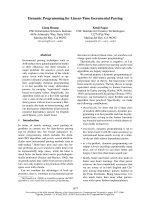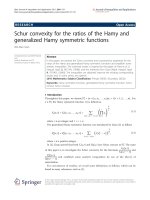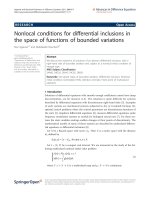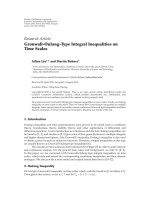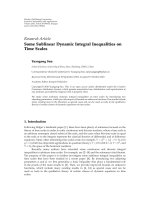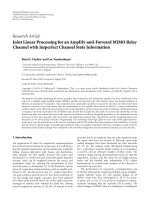Báo cáo hóa học: "LYAPUNOV FUNCTIONS FOR LINEAR NONAUTONOMOUS DYNAMICAL EQUATIONS ON TIME SCALES" doc
Bạn đang xem bản rút gọn của tài liệu. Xem và tải ngay bản đầy đủ của tài liệu tại đây (510.11 KB, 10 trang )
LYAPUNOV FUNCTIONS FOR LINEAR NONAUTONOMOUS
DYNAMICAL EQUATIONS ON TIME SCALES
PETER E. KLOEDEN AND ALEXANDRA ZMORZYNSKA
Received 25 January 2006; Revised 23 March 2006; Accepted 13 April 2006
The existence of a Lyapunov function is established following a method of Yoshizawa for
the uniform exponential asymptotic stability of the zero solution of a nonautonomous
linear dynamical equation on a time scale with uniformly bounded graininess.
Copyright © 2006 P. E. Kloeden and A. Zmorzynska. This is an open access article dis-
tributed under the Creative Commons Attribution License, which permits unrestricted
use, distribution, and reproduction in any medium, provided the original work is prop-
erly cited.
1. Introduction
Lyapunov functions are a very useful tool for investigating the behaviour of dynamical
equations. They have been used now for over a century for differential equations of many
types [15]aswellasdifference equations [1]. They were first used in the context of time
scales in [12]. See [16] for a more recent and an extensive investigation of Lyapunov
functions on time scales.
Much of the literature on Lyapunov functions, especially applications oriented, deals
with sufficient conditions, assuming that a Lyapunov function is known. An important
theoretical issue with practical implications is whether or not a Lyapunov function char-
acterizing a particular dynamical property actually exists—such results are known as nec-
essary conditions.
In this paper, we establish the existence of a Lyapunov function characterising the
uniform exponential asymptotic stability of the zero solution of a nonautonomous linear
dynamic equation
x
Δ
= A(t)x (1.1)
on a time scale
T with a bounded graininess, where the matrix-valued mapping t → A(t)
is right dense continuous (rd-continuous) on
T, that is, A ∈ Ꮿ
rd
(T,R
n×n
).
Such linear dynamical equations and their inhomogeneous variants play an impor-
tant role in investigations of the dynamical behaviour, both in themselves and also as
Hindawi Publishing Corporation
Advances in Difference Equations
Volume 2006, Article ID 69106, Pages 1–10
DOI 10.1155/ADE/2006/69106
2 Lyapunov functions for dynamical equations
linearizations of nonlinear systems, see, for example, [3, 7, 11]. We note that P
¨
otzsche
et al. [13] investigated various necessary and sufficient conditions for the uniform expo-
nential stability of the zero solution of systems (1.1) in terms of spectral properties rather
than Lyapunov functions.
In the next section, we show the invertibility of the cylinder transformation on the
Hilger complex plane. This is required in our main result, which is presented and proved
in the final section.
Background concepts and results on time scales are taken from Bohner and Peterson
[4] (see also [2, 5, 8, 9]) and, for brevity, will not be stated explicitly here in general.
2. Invertibility of the cylinder transformation
A classical result from function theory (see, e.g., [6, Pages 38–45]) says that the main
branch of the complex logarithm Log(z):
= log(|z|)+ıφ,wherez =|z|e
ıφ
with −π<φ≤
π,iswelldefinedforz ∈ C
∗
:=
C \{
0}, but is not continuous for z ∈ C
∗
with Im(z) = π.
Moreover, Log(z) is a holomorphic function for z
∈ C
−
:=
C \{
z ∈ R : z ≤ 0}.
Define
C
h
and Z
h
for h>0by
C
h
:=
z ∈ C : z =−
1
h
, Z
h
:=
z ∈ C : −
π
h
< Im(z) <
π
h
. (2.1)
C
h
is called the Hilger complex plane. Hilger [10]alsointroducedthecylinder transfor-
mation ξ
h
: C
h
→ Z
h
, which is defined by
ξ
h
(z):=
⎧
⎪
⎨
⎪
⎩
1
h
Log(1 + zh), h>0,
z, h
= 0.
(2.2)
Proposition 2.1 (Hilger [10]). Let
T be a time scale with graininess μ and let p∈Ꮿ
rd
(T,C)
be regressive on
T. Then the composition ξ
μ
(p) of the cylinder transformation with μ and p
is well defined, rd-continuous on
T, and thus Cauchy integrable.
The cylinder transformation is useful for investigating, among other things, linear dy-
namical equations. It is invertible when suitably restricted.
Lemma 2.2. Let
A
h
:={z ∈ C
h
: z<−1/h} for h>0 and define ξ
h
: C
h
\ A
h
→ Z
h
by
ξ
h
(z):=
1
h
Log(1 + zh). (2.3)
Then ξ
h
is a biholomorphism of C
h
\ A
h
onto Z
h
and its inverse ξ
−1
h
: Z
h
→ C
h
\ A
h
is
given by
ξ
−1
h
(z):=
exp(zh) − 1
h
. (2.4)
Proof. Since ξ
h
and ξ
−1
h
are well defined and continuous, it remains to prove that
(1) ξ
h
(C
h
\ A
h
) ⊂ Z
h
and ξ
−1
h
(ξ
h
(z)) = z for all z ∈ C
h
\ A
h
.
P. E. Kloeden and A. Zmorzynska 3
Let z
∈ C
h
\ A
h
.Then1+zh ∈ C
−
and
ξ
h
(z) =
1
h
Log(1 + zh)
=
log|1+zh|
h
+ i
·
Arg(1 + zh)
h
(2.5)
with
−π<Ar g(1 + zh) <π, from which it follows that
−
π
h
<
Arg(1 + zh)
h
<
π
h
, (2.6)
hence ξ
h
(C
h
\ A
h
) ⊂ Z
h
. Furthermore, a classical result from function theory says that
exp(Log(1 + zh))
= 1+zh for z ∈ C
h
\ A
h
and h>0 (see, e.g., [14, Pages 120 and 126]).
Hence
ξ
−1
h
ξ
h
(z)
=
exp
h · (1/h)Log(1+zh)
−
1
h
=
1+zh − 1
h
= z. (2.7)
(2) ξ
−1
h
(Z
h
) ⊂ C
h
\ A
h
and ξ
h
(ξ
−1
h
(z)) = z for all z ∈ Z
h
.
We assume that there exists a z
∈ Z
h
such that for h>0
exp(zh)
≤−
1
h
. (2.8)
Applying Euler’s formula we see that (2.8)holdsforz
∈ Z
h
if and only if Im(z) = 0, that is,
z
∈ R. But then a contradiction follows directly from (2.8), since the exponential function
is strictly positive on
R.Henceξ
−1
h
(Z
h
) ⊂ C
h
\ A
h
.Wehave−π/h< Im(z) <π/hwhenever
z
∈ Z
h
.Itthenfollowsfrom[14, Pages 120 and 126] that Log(exp(zh)) = zh and hence
1
h
Log
1+h ·
exp(zh) − 1
h
=
1
h
Log
exp(zh)
=
z (2.9)
for z
∈ Z
h
and h>0.
We have shown that ξ
h
: C
h
\ A
h
→ Z
h
is bijective with inverse function ξ
−1
h
: Z
h
\ A
h
.
From function theory, it is known that exp is a holomorphism on
C and that Log is a
holomorphism on
C
−
(see, e.g., [14, Page 64]). Hence ξ
h
is a holomorphism on C
h
\ A
h
and ξ
−
h
is a holomorphism on Z
h
for h>0.
Remark 2.3. Write C
0
:=
C
for h = 0. Then we define ξ
0
:= id on C and ξ
−1
0
:= id on all of
C, where id is the identity function on C.
For fixed c
∈ R, the composition of the inverse cylinder transformation with the grain-
iness μ ofatimescale
T wil l be needed in considering Lyapunov functions. Let c ∈ R be
fixed and
ξ
c
: T → R be defined by
ξ
c
(t):=
⎧
⎪
⎪
⎨
⎪
⎪
⎩
exp
μ(t) · c
−
1
μ(t)
, t<σ(t),
c, t
= σ(t).
(2.10)
4 Lyapunov functions for dynamical equations
Then
(i) the function t
→ ξ
c
(t)isrd-continuousinallt ∈ T for arbitrary c ∈ R as the
composition of the graininess function t
→ μ(t), which is always rd-continuous
(see [4, Example 1.59 and Theorem 1.60, Page 22]) and the continuity of f :
R →
R
defined by
f (x):
=
⎧
⎪
⎨
⎪
⎩
exp(x) − 1
x
, x
= 0,
1, x
= 0;
(2.11)
(ii) since f (x) > 0forallx
∈ R,forc>0, it follows that ξ
c
(t) > 0forallt ∈ T and for
c<0, it follows that
ξ
c
(t) < 0forallt ∈ T;
(iii) moreover,
ξ
c
(t) = c for all right dense t ∈ T;
(iv) for h>0, let
T := hZ,thenμ(t) = h and
ξ
c
(t) =
exp(h · c)
h
(2.12)
for all t
∈ T, that is, t → ξ
c
(t) is a constant function.
3. Existence of a Lyapunov function
Our main result, the following theorem, is a necessary condition for the existence of a Lya-
punov function characterizing the uniform exponential asymptotic stability of the zero
solution of a nonautonomous linear dynamical equation. It is adapted from Yoshizawa
[15, Theorem 19.1] for linear ordinary differential equations.
Theorem 3.1. Let
T be an unbounded time scale with bounded graininess and suppose that
for each t
0
∈ T, x
0
∈ R
n
, there exists a classical solution y : T → R
n
, y(t) = y(t,t
0
,x
0
) of the
initial value problem (IVP)
y
Δ
= A(t)y, A ∈ Ꮿ
rd
(T,R
n×n
), t ∈ T,
y(t
0
) = x
0
, x
0
∈ R
n
, t
0
∈ T,
(3.1)
for all t
∈ T, t ≥ t
0
. Furthermore, suppose that there exist constants K>0 and c>0,which
can be chosen independently of t
0
such that
y
t,t
0
,x
0
≤
Ke
−c(t−t
0
)
x
0
(3.2)
holds for any t
0
∈ T, x
0
∈ R
n
,andallt ≥ t
0
, that is, the zero solution is uniformly exponen-
tially stable.
Then there exists a function V :
T × R
n
→ R such that
(i)
x≤V (t, x) ≤ Kx for all x ∈ R
n
, t ∈ T;
(ii)
|V(t,x) − V(t, x)|≤Kx − x for any fixed t ∈ T and all x, x ∈ R
n
;
P. E. Kloeden and A. Zmorzynska 5
(iii) for arbitrary fixed (t
0
,x
0
) ∈ T × R
n
, define function V
∗
: T → R, V
∗
(t):= V(t, y(t)),
where y(t)
= y(t,t
0
,x
0
), then the upper right Dini derivative of V
∗
defined by
V
Δ
∗
(t):=
⎧
⎪
⎪
⎪
⎪
⎨
⎪
⎪
⎪
⎪
⎩
lim
h0,h+t∈T
V
∗
(t + h) −V
∗
(t)
h
, if t
= σ(t),
V
∗
σ(t)
−
V
∗
(t)
μ(t)
, if t<σ(t),
(3.3)
exists and the estimate
V
Δ
∗
(t) ≤ ξ
−c
(t)V
∗
(t) < 0 (3.4)
holds for all t
≥ t
0
;
(iv) V is continuous from the right in (t,x)
∈ T × R
n
,thatis,
lim
(
t,x)→(t,x),
t≥t
V
t, x
−
V(t,x)
=
0. (3.5)
Proof. Fix t
∈ T.Thenwedefine
A
t
:=
τ ∈ [0,∞):t + τ ∈ T
, (3.6)
since 0
∈ A
t
, we note that A
t
is nonempty. Further, we define V : T ×R
n
→ R by
V(t,x):
= sup
τ∈A
t
y(t + τ, t,x)
e
cτ
, (3.7)
where y :
T → R
n
is the unique solution of (3.1)withinitialvaluey(t) = x. Equation (3.7)
is well defined since y exists for all initial values (t,x)
∈ T × R
n
and all t + τ, τ ∈ A
t
by
assumption and, as we will see in detail, it also follows from the assumptions that V is
bounded.
It will be shown that V satisfies the properties (i)–(iv) asserted in the theorem.
It is obvious from the definition of V that
x≤V (t, x), while from (3.2)itfollows
for all τ
∈ A
t
that
y(t + τ, t,x)
≤
Ke
−c(t+τ−t)
x=Ke
−cτ
x, (3.8)
so
V(t,x)
= sup
τ∈A
t
y(t + τ, t,x)
e
cτ
≤ sup
τ∈A
t
Ke
−cτ
xe
cτ
= Kx. (3.9)
Thus V satisfies property (i).
6 Lyapunov functions for dynamical equations
Let t
∈ T be fixed and let x, x ∈ R
n
be arbitrary. By the triangle inequality and the
superposition of solutions of a linear system, we have
V(t,x) − V
t, x
=
sup
τ∈A
t
y(t + τ, t,x)
e
cτ
− sup
τ∈A
t
y
t + τ,t, x
e
cτ
=
sup
τ∈A
t
e
cτ
y(t + τ, t,x)
−
y
t + τ,t, x
≤
sup
τ∈A
t
e
cτ
y(t + τ, t,x) − y
t + τ,t, x
≤
sup
τ∈A
t
e
cτ
y
t + τ,t,x − x
=
V
t,x − x
≤
K
x − x
,
(3.10)
which shows that V is globally Lipschitz—continuous in x for fixed t
∈ T, that is, satisfies
property (ii).
We will prove property (iii) next. Let (t
0
,x
0
) ∈ T × R
n
be arbitrary. We will distinguish
two cases, σ(t)
= t and σ(t) >tin the proof.
Suppose that σ(t)
= t and let h ∈ A
t
.Then
V
Δ
∗
(t) = lim
h0,h∈A
t
V
∗
(t + h) −V
∗
(t)
h
, (3.11)
where, by the uniqueness of solutions of (3.1) (see [4, Theorem 8.20, Page 324]), it follows
that
V
∗
(t + h) = sup
τ∈A
t+h
y
t + h +τ,t +h, y
t + h,t
0
,x
0
e
cτ
= sup
τ∈A
t+h
y
t + h +τ,t, y
t,t
0
,x
0
e
cτ
= sup
τ∈{τ∈[h,∞):t+τ∈T}
y
t + τ,t, y
t,t
0
,x
0
e
cτ
e
−ch
≤ sup
τ∈{τ∈[0,∞):t+τ∈T}
y
t + τ,t, y
t,t
0
,x
0
e
cτ
e
−ch
= V
∗
(t)e
−ch
,
(3.12)
hence we have
V
Δ
∗
(t) ≤ lim
h0
V
∗
(t) ·
e
−ch
− 1
h
= V
∗
(t) · (−c) = V
∗
(t) · ξ
−c
(t), (3.13)
since μ(t)
= 0 by assumption.
Now suppose that σ(t) >t, in which case
V
Δ
∗
(t) =
V
∗
σ(t)
−
V
∗
(t)
μ(t)
. (3.14)
P. E. Kloeden and A. Zmorzynska 7
But
V
∗
σ(t)
=
sup
τ∈A
σ(t)
y
σ(t)+τ,σ(t), y
σ(t),t
0
,x
0
e
cτ
= sup
τ∈A
μ(t)+t
y
μ(t)+t + τ,μ(t)+t, y
μ(t)+t,t
0
,x
0
e
cτ
= sup
τ∈{τ∈[μ(t),∞):t+τ∈T}
y
t + τ,t, y
t,t
0
,x
0
e
cτ
e
−μ(t)c
≤ V
∗
(t)e
−cμ(t)
,
(3.15)
so
V
Δ
∗
(t) ≤ V
∗
(t) ·
e
−cμ(t)
− 1
μ(t)
= V
∗
(t) · ξ
−c
(t), (3.16)
thus property (iii) follows from (3.13)and(3.16).
In order to show that V is continuous in the sense of (iv), let t
∈ T, x ∈ R
n
be fixed
and choose ε>0 arbitrary. Then δ
1
> 0andδ
2
> 0 must be found such that
V
t, x
−
V(t,x)
<ε (3.17)
holds for all
t = t + ν, ν ∈ A
t
,0≤ ν <δ
1
(3.18)
and all
x ∈ B
δ
2
(x), where B
δ
2
(x) is the open ball centered on x of radius δ
2
.
If t
∈ T is right scattered, we can always choose a suitable δ
1
> 0suchthat
t = t is
the only point satisfying condition (3.18). Then the assertion follows since V is globally
Lipschitz continuous in x for fixed t
∈ T.
Let t
∈ T be right dense and
t = t + ν for ν ∈ A
t
.Then(3.17)willfollowfromthe
inequalities
V
t, x
−
V(t,x)
=
V
t + ν, x
−
V(t,x)
≤
V
t + ν, x
−
V(t + ν,x)
+
V(t + ν,x) − V
t + ν, y(t + ν, t,x)
+
V
t + ν, y(t + ν, t,x)
−
V(t,x)
.
(3.19)
Now we can use the Lipschitz continuity of V in x to estimate
V
t + ν, x
−
V(t + ν,x)
≤
K
x − x
. (3.20)
Hence
V
t + ν,x
−
V(t + ν,x)
<
ε
3
(3.21)
for all x
∈ B
δ
2
(x)whenδ
2
<ε/3K.
8 Lyapunov functions for dynamical equations
In addition, the Lipschitz continuity of V in x also implies that
V(t + ν,x) − V
t + ν, y(t + ν, t,x)
≤
K
x − y(t + ν,t,x)
, (3.22)
where, by the right continuity of y,wehave
lim
ν→0,ν∈A
t
y(t + ν,t,x) = x, (3.23)
hence there exists a δ
1
> 0, such that
x − y(t + ν,t,x)
<
ε
3
·
1
K
(3.24)
for all ν
∈ A
t
with 0 ≤ ν <δ
1
, which combines with (3.22)togive
V(t + ν,x) − V
t + ν, y(t + ν, t,x)
≤
ε
3
(3.25)
for all ν
∈ A
t
with 0 ≤ ν <δ
1
.
In order to estimate the last term in (3.19), we use the uniqueness of solutions of our
initial value problem (3.1) (see [4, Theorem 8.20, Page 324]) to obtain
y
t + ν +τ,t +ν, y(t + ν,t, x)
=
y(t + ν +τ,t,x). (3.26)
Define
ΔV :
=
V
t + ν, y(t + ν, t,x)
−
V(t,x)
, (3.27)
that is,
ΔV
=
sup
τ∈A
t+ν
y(t + ν +τ,t,x)
e
cτ
− sup
τ∈A
t
y(t + τ, t,x)
e
cτ
. (3.28)
Rearrangement gives
sup
τ∈A
t+ν
y(t + ν +τ,t,x)
e
cτ
= sup
τ∈{τ∈[ν,∞):t+τ∈T}
y(t + τ, t,x)
e
cτ
e
−cν
, (3.29)
so (3.28)canberewrittenas
ΔV
=
sup
τ∈{τ∈[ν,∞):τ+y∈T}
y(t + τ, t,x)
e
cτ
e
−cν
− sup
τ∈{τ∈[0,∞):t+τ∈T}
y(t + τ, t,x)
e
cτ
.
(3.30)
Define α(ν):
= sup
τ∈{τ∈[ν,∞):t+τ∈T}
y(t + τ, t,x)e
cτ
for ν ∈ A
t
.Then
ΔV
≤
α(ν)e
−cν
− α(0)
. (3.31)
P. E. Kloeden and A. Zmorzynska 9
Now α(ν)
≤ α(0) for all ν ∈ A
t
,whereν ≥ 0 by definition. Moreover, α(ν)isnonin-
creasing function in ν with
lim
ν→0,ν∈A
t
α(ν) = α(0). (3.32)
Hence, there exists a δ
1
> 0suchthatΔV<ε/3forallν ∈ A
t
with 0 ≤ ν ≤ δ
1
.
Now choose δ
1
:= min{δ
1
,δ
1
}.For
t = t + ν with ν ∈ A
t
,where0≤ ν <δ
1
and x ∈
B
δ
2
(x), combining all of the above estimates of the terms in (3.19), then gives
V
t, x
−
V(t,x)
<
ε
3
+
ε
3
+
ε
3
= ε, (3.33)
which proves property (iv) and completes the proof of Theorem 3.1.
Acknowledgments
Peter Kloeden has been partly supported by the Ministerio de Educaci
´
on y Ciencia Project
MTM2005-01412 as well by the Programa de Movilidad del Profesorado Universitario
Espa
˜
nol y Extranjero, Grant SAB2004-0146 of the above ministerio.
References
[1] R. P. Agarwal, Difference Equations and Inequalities, Monographs and Textbooks in Pure and
Applied Mathematics, vol. 155, Marcel Dekker, New York, 1992.
[2] R.P.Agarwal,M.Bohner,D.O’Regan,andA.Peterson,Dynamic equations on time scales: a
survey, Journal of Computational and Applied Mathematics 141 (2002), no. 1-2, 1–26.
[3] B.AulbachandS.Hilger,Linear dynamic processes with inhomogeneous time scale, Nonlinear
Dynamics and Quantum Dynamical Systems (Gaussig, 1990), Math. Res., vol. 59, Akademie,
Berlin, 1990, pp. 9–20.
[4] M. Bohner and A. Peterson, Dynamic Equations on Time Scales,Birkh
¨
auser Boston, Mas-
sachusetts, 2001.
[5] M. Bohner and A. Peterson (eds.), Advances in Dynamic E quations on Time Scales,Birkh
¨
auser
Boston, Massachusetts, 2003.
[6] J.B.Conway,Functions of One Complex Variable I, 2nd ed., Graduate Texts in Mathematics,
vol. 11, Springer, New York, 1978.
[7] A. D
¨
offinger, Theorie dynamischer Gleichungen—ein einheitlicher Zugang zur kontinuierlichen
und diskreten Dynamik, Diplomarbeit, Universit
¨
at Augsburg, Augsburg, 1995.
[8] S. Hilger, Ein Maßkettenkalk
¨
ul mit Anwendung auf Zentrumsmannigfaltigkeiten, Dissertation,
Universit
¨
at W
¨
urzburg, W
¨
urzburg, 1988.
[9]
, Analysis on measure chains—a unified approach to continuous and discrete calculus,Re-
sults in Mathematics 18 (1990), no. 1-2, 18–56.
[10]
, Special functions, Laplace and Fourier transform on measure chains, Dynamic Systems
and Applications 8 (1999), no. 3-4, 471–488.
[11] S. Keller, Asymptotisches Verhalten invarianter Faserb
¨
undel bei Diskretisierung und Mittelwert-
bildung im Rahmen der Analysis auf Zeitskalen, Dissertation, Universit
¨
at Augsburg, Augsburg,
1999.
[12] P. E. Kloeden and S. Hilger, The effect of time granularity on the asymptotic stability of dynamical
systems, Automation and Remote Control 55 (1994), no. 9, part 1, 1293–1298 (1995).
10 Lyapunov functions for dynamical equations
[13] C. P
¨
otzsche, S. Siegmund, and F. Wirth, A spectral characterisation of exponential stability for lin-
ear time-invariant systems on time scales, Discrete and Continuous Dynamical Systems 9 (2002),
255–265.
[14] R. Remmert, Funktionentheorie, Springer, Berlin, 1995.
[15] T. Yoshizawa, Stability Theory by Liapunov’s Second Method, Publications of the Mathematical
Society of Japan, no. 9, The Mathematical Society of Japan, Tokyo, 1966.
[16] A. Zmorzynska, Lyapunovfunktionen auf Zeitskalen, Diplomarbeit, Johann Wolfgang Goethe
Universit
¨
at, Frankfurt am Main, 2004.
Peter E. Kloeden: Institut f
¨
ur Mathematik, Johann Wolfgang Goethe Universit
¨
at,
60054 Frankfurt am Main, Germany
E-mail address:
Alexandra Zmorzynska: Institut f
¨
ur Mathematik, Technische Universit
¨
at Berlin,
10623 Berlin, Germany
E-mail address:
